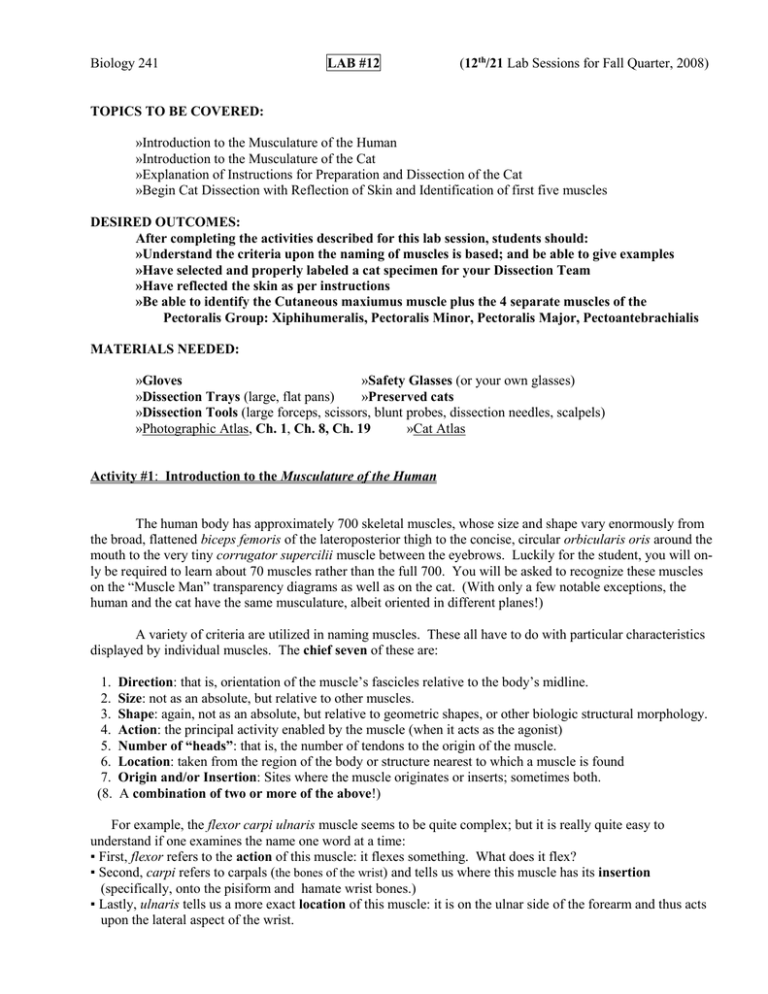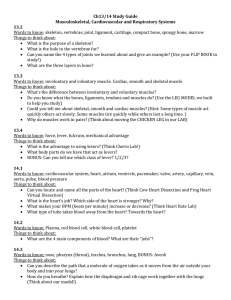Biology 241 LAB #12 »Introduction to the Musculature of the Human
advertisement

Biology 241 LAB #12 (12th/21 Lab Sessions for Fall Quarter, 2008) TOPICS TO BE COVERED: »Introduction to the Musculature of the Human »Introduction to the Musculature of the Cat »Explanation of Instructions for Preparation and Dissection of the Cat »Begin Cat Dissection with Reflection of Skin and Identification of first five muscles DESIRED OUTCOMES: After completing the activities described for this lab session, students should: »Understand the criteria upon the naming of muscles is based; and be able to give examples »Have selected and properly labeled a cat specimen for your Dissection Team »Have reflected the skin as per instructions »Be able to identify the Cutaneous maxiumus muscle plus the 4 separate muscles of the Pectoralis Group: Xiphihumeralis, Pectoralis Minor, Pectoralis Major, Pectoantebrachialis MATERIALS NEEDED: »Gloves »Safety Glasses (or your own glasses) »Dissection Trays (large, flat pans) »Preserved cats »Dissection Tools (large forceps, scissors, blunt probes, dissection needles, scalpels) »Photographic Atlas, Ch. 1, Ch. 8, Ch. 19 »Cat Atlas Activity #1: Introduction to the Musculature of the Human The human body has approximately 700 skeletal muscles, whose size and shape vary enormously from the broad, flattened biceps femoris of the lateroposterior thigh to the concise, circular orbicularis oris around the mouth to the very tiny corrugator supercilii muscle between the eyebrows. Luckily for the student, you will only be required to learn about 70 muscles rather than the full 700. You will be asked to recognize these muscles on the “Muscle Man” transparency diagrams as well as on the cat. (With only a few notable exceptions, the human and the cat have the same musculature, albeit oriented in different planes!) A variety of criteria are utilized in naming muscles. These all have to do with particular characteristics displayed by individual muscles. The chief seven of these are: 1. 2. 3. 4. 5. 6. 7. (8. Direction: that is, orientation of the muscle’s fascicles relative to the body’s midline. Size: not as an absolute, but relative to other muscles. Shape: again, not as an absolute, but relative to geometric shapes, or other biologic structural morphology. Action: the principal activity enabled by the muscle (when it acts as the agonist) Number of “heads”: that is, the number of tendons to the origin of the muscle. Location: taken from the region of the body or structure nearest to which a muscle is found Origin and/or Insertion: Sites where the muscle originates or inserts; sometimes both. A combination of two or more of the above!) For example, the flexor carpi ulnaris muscle seems to be quite complex; but it is really quite easy to understand if one examines the name one word at a time: ▪ First, flexor refers to the action of this muscle: it flexes something. What does it flex? ▪ Second, carpi refers to carpals (the bones of the wrist) and tells us where this muscle has its insertion (specifically, onto the pisiform and hamate wrist bones.) ▪ Lastly, ulnaris tells us a more exact location of this muscle: it is on the ulnar side of the forearm and thus acts upon the lateral aspect of the wrist. Biology 241 – LAB #12 – continued Page Two Now, combining the information from all three parts of the name: we know that this muscle flexes those carpi that are aligned with the ulna; that is, it flexes the wrist laterally. Stated another way: it flexes and adducts the hand (ulnar deviation) at the wrist joint. Try using this analysis procedure to match each part of the name of a muscle to the numbered criteria; thus, allowing the name to reveal most of the important characteristics about the particular muscle. (Please refer to TABLE 11.2 in your text for more examples.) Activity #2: Introduction to the Musculature of the Cat Dissection of the cat musculature is intended to complement your study of human muscles. Some muscles found in animals are lacking in humans; other muscles that are fused in humans occur as distinct, separate muscles in animals. Also, the terminology used to describe location and position of body parts for quadriped animals differs slightly from that used for biped humans, since four-legged animals move forward head-first with the abdominal surface parallel to the ground. Even “anatomical position” is defined differently: for a four-legged animal, it is all four limbs on the ground; thus, “superior” refers to the back or dorsal surface, and “inferior” relates to the belly or ventral surface. Cephalic means toward the front or anterior, and caudal refers to posterior structures. Also, in quadripeds, the radial side of the forearm is medial, not lateral. You will need to start bringing with you to Lab the thin, blue book entitled: Pictorial Anatomy of the Cat (Revised Edition) by Stephen G. Gilbert that was on the list of required materials for Biology 241. This small volume is more commonly referred to as your “Cat Atlas”. The illustrations in this Atlas are helpful for both initial study of musculature as well as for review; but the main purpose of the Atlas is to act as a “roadmap” for your own experiential journey through the most classic, hands-on activity of an anatomy lab: dissection. To paraphrase one of the “greats” of vertebrate anatomy instruction, Dr. Libbie Hyman, …Anatomy is best studied and learned not out of books, but by actual experience with and handling of material. It is hoped that the student will learn about the various organs and systems by comparing their condition (in the different animals) dissected rather than by looking at diagrams in books!’ Please keep in mind that many variations occur in the structures, and even arrangements, of individual specimens. The “Cat Atlas” describes the norm (or most commonly occurring morphology), and the numerous variations which may be encountered in the laboratory are not always described. Students should not be surprised, therefore, if their specimen does not exactly resemble the illustrations in the Cat Atlas. The main idea of the Cat Atlas is to serve as a record for what you will be seeing as we progress through a sequential investigation of the superficial muscles during the next several lab sessions. (Next quarter, the ventral body cavity will be accessed and the full contents of the thoracic and abdominopelvic cavities will be examined. This will be done in connection with our study of body systems that are presented in Biology 250/251 including endocrine, cardiovascular (blood, heart, vessels), lymphatic/immune, respiratory, digestive/metabolism, urinary, and reproductive systems). Activity #3: Instructions for Preparation, Storage and Dissection of the Cat All students must practice the highest levels of lab safety while handling/dissecting the cat. Please observe the following guidelines during any of the “cat labs”: 1. Wear your lab coat, gloves and safety glasses to protect yourself from the fixative (ethylene glycol) used to preserve the cats. 2. On first opening the cat’s sealed bag, you may dispose of excess fluid; but thereafter, you should allow excess fluid to remain as it will keep your specimen moist during storage and it will help prevent decay. Biology 241 – LAB #12 – continued Page Three 3. When using sharp instruments, always direct cutting and scissor motions away from you to prevent an accident if the instrument slips on moist tissues. (For cutting, always try scissors FIRST; please use scalpels only VERY sparingly.) 4. Before doing any cutting, make sure that the tissue is freed from underlying or adjacent tissues so that they will not be accidentally severed. Additionally, do not force any sharp instrument directly downward, but rather use an obliquely-horizontal motion. This will avoid cutting too deeply and inadvertently involving layers not intended to be cut. 5. FOLLOW DIRECTIONS GIVEN IN CLASS – there will always be certain procedures that will be explained as a demonstration at the beginning of the lab session; as well as certain instructions that will be presented. 6. Read your LAB protocol in its entirety and familiarize yourself completely with the activity before proceeding. 7. Since the skin is NOT removed completely, it stays in position to rewrap the body for storage. (This keeps the body moist and prevents excessive drying of the muscles. BE SURE TO CAREFULLY WRAP the skin around the body after each use.) You may also supplement the skin wrap with some paper towels. 8. Store your cat in TWO plastic bags: the one it came in and one additional bag provided. Seal the bags, making sure to remove as much air as possible before attaching the twist-tie. (Remove air by rolling entire package on the counter-top.) 9. Attach a name tag with your “dissection team’s” names, Lab Section, and cat’s name (if you named it!) 10. Place the sealed, well-labeled bag in the assigned storage container. Here are the step-wise instructions for reflection of the skin: 1. After removal of the specimen from its plastic bag and discarding excess fluid (this first time ONLY), place the cat ventral side up on a dissecting tray. (Do NOT rinse your cat with water as this will remove the preservative and promote the growth of mold!!) 2. Using large forceps, grasp a small “pinch” of skin in the midline of the mid-chest, and gently insert the point of the sharp blade of a scissors to pierce through the fold of skin. Now, through this small opening, insert a blunt probe or your finger to separate the skin from underlying fascia and muscle. Extend the initial incision cranially by cutting the separated skin with scissors (NOT a scalpel), continuing to separate with the probe and cut with scissors until you have an incision that extends up to just below the mandible. (Remember: when using scissors, place the blunt-ended blade of the scissors under the skin.) 3. Do the same in the opposite direction ALONG THE MIDLINE, continuing to extend the initial incision caudally by cutting with scissors and separating with blunt probe or fingers until reaching within an inch of the symphysis pubis. 4. On either side of the midventral incision, separate and reflect as much skin laterally as possible from its underlying fascia and muscle. YOU WILL NOTE, there is a great deal of areolar C.T. that can be disrupted quite easily with just back-and-forth motions of your gloved hand 5. Now, from the ventral surface, several other incision lines will have to be made as follows: (AN IMPORTANT CAUTION HERE: AGAIN always make sure to separate the skin from the underlying tissues using a blunt probe or your finger PRIOR to making any CUTS!) a. Complete encirclement of the skin of the neck parallel to the base of the skull. b. Along the ventral aspect of each forelimb starting at the initial midline incision and proceeding to each wrist – making sure to proceed DISTAL TO (ie go beyond) the dewclaw. (You will soon enough need to hold on to the dewclaw to help cut the adherent connective tissue anchoring it for removal of the skin over the wrists.) c. Complete encirclement of each wrist; a cut referred to as the “cuff-cut”. d. Similarly for the hindlimbs: along the ventral aspect of each hindlimb starting at the end of the midline cut and proceeding to each ankle – making sure to proceed DISTAL TO the calcaneus. e. Complete cuff-cuts around each ankle. 6. Go back to loosen the skin as much as possible using your fingers. (If the skin does not come off easily, it must be freed by cutting. Please call your Instructor over to your table if this is the case. Explanation of additional dissection techniques will be made as needed. THIS WILL BE ESPECIALLY TRUE IN THE NECK REGION where the skin is thickened and very snugly adherent to the underlying fascia.) Biology 241 – LAB #12 – continued Page Four 7. In three places EXTRA CARE should be taken to ensure special handling of the muscles underlying the skin: a. In the lateral thoracic area, you will observe muscle fibers lying within the superficial fascia and attached directly to the skin. These fibers are part of the cutaneous maximus, originating from the muscles of the axilla and from the ventral side of the abdomen and thorax, and inserting into the skin. It serves to “twitch” the skin, as in avoiding irritants. DO elevate the cutaneous maximus muscle WITH THE SKIN. b. The deep fascia of the superiolateral-most border of the latissimus dorsi muscle adheres snugly to the sub-Q of the skin and will try to lift off with the skin if extra care is not taken to separate the two. DO NOT elevate the latissiumus dorsi muscle WITH THE SKIN. c. The brachioradialis muscle on the dorsal aspect of each forelimb is so superficial that it will elevate with the skin if care is not taken to prevent this. In reflecting the skin of each forelimb, go very slowly as you pass from the distal humerus region and start elevating the skin over the radius and ulna area. The brachioradialis muscle will be a very thin, ribbon-like band of skeletal muscle that will try to lift off with the skin. Instead, use your blunt scissors to carefully cut between its deep fascia and the superficial fascia thus preserving the integrity of and position of this important forelimb muscle. DO NOT elevate the brachioradialis muscle WITH THE SKIN. 8. Use your fingers to free the skin from loose connective tissue attaching the skin to the underlying structures. Work from the ventral aspect laterally towards the dorsal aspect. When necessary, flip your cat over so that it lies on its ventral surface with the dorsal surface facing you. AS YOU COME TO WITHIN 1” OF THE VERTEBRAL COLUMN, DO NOT REFLECT THE SKIN ANY FURTHER. 9. When you have proceeded on both sides with Steps #4 - #7, you will have separated and reflected all of the skin EXCEPT along a 1” band overlying the vertebral column in the midline of the dorsal aspect of your cat. This will serve to keep the skin “in place” while still “reflected”. 10. Depending upon your specimen, you may observe some or all of the following: a. while pulling the skin away from the body, you see that it is connected to the underlying structures by a white, fibrous substance consisting of collagen, elastic and reticular fibers and fat. This layer of connective tissue is the superficial fascia (aka sub Q) and is distinguishable from the deep fascia, which is the tough fibrous substance investing the individual muscles; b. thin, rubber band-like red or blue latex-injected blood vessels projecting between the muscles and the skin; c. mammary glandular tissue just deep to the skin in female cats (This structure may be quite well-developed and prominant in pregnant females) IF YOUR CAT IS A PREGNANT FEMALE, HAVE YOUR MIDLINE INCISION DIVERGE so that cuts are made around the nipples, leaving this tissue intact an an “island” in the midline; d. superficial, cutaneous nerves which are small, white, cordlike structures extending through the muscles to the skin; e. In male cats, terminate the mid-line incision a good 1” above the symphysis pubis and leave intact the skin associated with the male external genitalia and laterally adjacent area. (More dissection of this area will be done when we study the reproductive system. We want to cause NO DAMAGE to these structures because of carelessness.) Two additional dissection instruction comments: 1) In order to define the limits of a muscle, use small scissors and forceps to trim away the overlying fat and fascia until you can see the direction of the fascicles. Look for a change in the direction of the fascicles near the place where the edge of the muscle belly should be, and attempt to slip the blunted point of a probe between two separate layers of muscle at this point. If one layer separates easily from another, you have your probe between two different muscles. Do not try to force the separation; instead, if you ARE looking in the right place, the separation will be natural. When it is necessary to cut a muscle in order to expose an underlying structure, call your Instructor over to discuss the best method to do this. 2) It is often helpful to confirm an observation made on the left side of the specimen by dissecting on the right. If you do this, leave intact the origins and insertions of any muscles you cut on the right and do not destroy any of the nerves or vessels, which will be studied later. Biology 241 – LAB #12 – continued Page Five Activity #4: Begin Dissection and Identification of first five muscles Begin your dissections as per instructions. The muscles assigned for today are: 1) Cutaneous maximus (aka the Great Cutaneous); 2) Pectoantebrachialis, 3) Pectoralis Major (two bellies: the large one caudal to and the smaller one cranial to the Pectoantebrachialis), 4) Pectoralis Minor, 5) Xiphihumeralis, (2-5 belong to the “Pectoralis Group” in the cat.) 1) The cutaneous maximus: in the lateral thoracic area, you will observe muscle fibers lying within the superficial fascia and attached directly to the skin. These fibers are part of the cutaneous maximus, which originates from the muscles of the axilla and from the ventral side of the abdomen and thorax, and inserts into the skin. Carefully cut through the superficially lying cutaneous maximus muscle and try to remove it WITH the skin. (Another muscle which moves the skin will be found in the area of the neck and face. This is the platysma, which inserts into the skin around the ears, eyes, and lips. We, however, will NOT be skinning the head and neck regions of our cats.) Muscle 2 – 5 belong to the pectoralis group which, in the cat, consists of the large muscles covering the ventral surface of the chest (see Figures 19.4, 19.8, 19.10 in the Photographic Atlas; and Figures 14 and 15 in the Cat Atlas). They arise from the sternum and attach, for the most part, to the humerus. There are five subdivisions in the cat, but only two in humans. (In the cat, the relatively large degree of “fusion” gives the cat’s pectoral muscles the appearance of a single muscle. This “fusion” makes it rather difficult to dissect, as they do not separate from each other easily.) 2) The most superficial of the pectoral muscles, the pectoantebrachialis, has its origin on the manubrium. It inserts onto the fascia of the forearm and adducts the arm. It is NOT FOUND in humans. This muscle may be separated from the underlying pectoralis major if one is careful to observe which way the fascicles run. 3) The much broader and triangular-shaped pectoralis major lies posterior to the pectoantebrachialis. Its origin is on the sternum and its insertion is on the posterior humerus. It functions to adduct the arm. The fascicles of the pectoralis major pass from the sternum, almost at right angles to the midline of the body, and insert on the proximal two thirds of the humerus between the biceps brachii and the brachialis. (In the human, the pectoralis major is much larger than the pectoralis minor – but this is NOT THE CASE in the cat.) There are TWO heads to the pectoralis major: the larger of the two is seen caudal to the pectoantebrachialis and the other (much smaller head) is seen cranial to it. 4) Posterior to the pectoralis major lies the pectoralis minor. This is the broadest and thickest muscle of the group. It extends posteriorly to the pectoralis major. It originates on the sternum, inserts near the proximal end of the humerus, and acts to adduct the arm. The pectoralis minor crosses obliquely, deep to the pectoralis major, and inserts on the proximal half of the humerus. 5) The thin xiphihumeralis is posterior to the posterior edge of the pectoralis minor. It originates on the xiphoid process of the sternum, passes obliquely deep to the pectoralis minor, and inserts by a narrow tendon near the proximal end of the humerus. It adducts and helps rotate the forelimb. It is NOT FOUND in humans. Another way to reinforce your learning is to review that from caudal to cranial these muscles align as follows: Xiphihumeralis Pectoralis minor Pectoralis major Pectoantebrachialis Pectoralis major These muscles (pectoantebrachialis, pectoralis major, pectoralis minor, and xiphihumeralis) act together (that is, synergistically) to rotate the forelimb and to draw the forelimb toward the chest.






